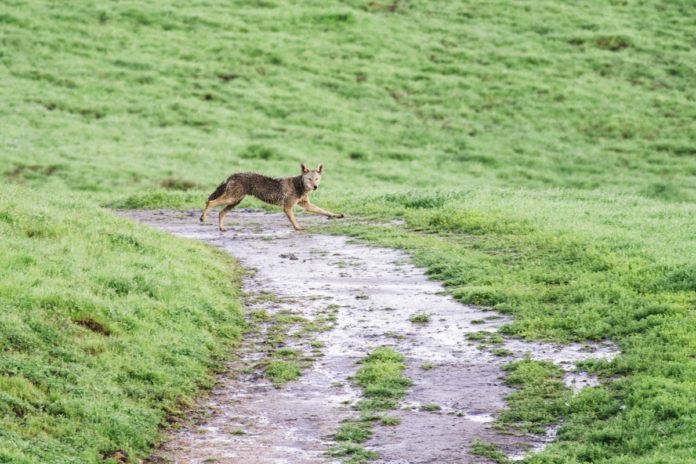As visitation to East Bay Regional Parks increases in warmer months, encounters with coyotes become more common. Coyotes are native to California and are found in various wildland habitats, as well as in rural and urban areas.
During the pup-rearing season (March-August), coyotes can be very protective of their pups. Visitors may experience a type of behavior known as escorting, in which a coyote follows at a closer distance than usual to encourage departure from the area. Coyotes might also make vocalizations or bare their teeth in ways that appear threatening; however, escorting does not usually result in aggression. The best course of action is to leave the area calmly and without running.
Coyote safety tips
1. Avoid hiking alone to ensure there is help in case of emergency.
2. Keep children and pets nearby; keep dogs on a leash.
3. Be aware of the surroundings when walking, jogging or riding.
4. Stay on designated trails.
5. Never attempt to feed a coyote.
What to do when you spot a coyote
Keep an eye on the coyote and observe from afar. Do not approach or engage with the coyote; walk away calmly and leave the area immediately. Do not run. Keep small children close by and dogs on a leash.
What to do if approached by a coyote
Most coyotes fear people, but those that learn to associate humans with food may adjust to the presence of humans. Documented coyote attacks on people are rare and are usually related to handfeeding or the presence of a dog. When a coyote is encountered within 50 feet and does not move away on its own, use the following tactics—known as hazing—to intimidate it and encourage it to maintain a safe distance.
1. Maintain eye contact.
2. Be as big and loud as possible.
3. Wave arms or use a tool like an umbrella to scare, but not injure, the animal.
4. If the coyote continues to approach, do not run or turn away. Continue to exaggerate the above gestures while backing away slowly.
To report a sick or injured coyote, or an aggressive encounter, contact the Non-Emergency Dispatch line at 510.881.1833. For any emergencies, call 911.
Coyotes and pets
Coyotes can pose a danger to pets. Understanding their behavior and modifying human actions can help promote peaceful coexistence. Most human-coyote conflicts in urban areas involve off-leash dogs. Follow these guidelines to keep dogs safe:
1. Obey leash laws and signage. If signs warn that coyotes have recently been active in the area, keep dogs closer than usual and be in control of their behavior. Never let dogs chase or play with a coyote.
2. Avoid walking at dawn/dusk when coyotes are particularly active.
3. Avoid walking near thick brush, which offers coyotes a natural hiding spot.
4. Consider purchasing a vest designed to deter coyotes and to prevent a lethal puncture if a coyote were to bite a pet.
When encountering a coyote, leash larger dogs, pick up smaller dogs, haze the coyote and leave the area calmly. Coyotes see domestic cats as prey, so keep cats indoors. Remember free-roaming cats are more likely to be killed by vehicles than coyotes. Keeping cats indoors also helps protect native birds and other wildlife.
In the neighborhood
Coexistence with local wildlife is a neighborhood effort. Do these five things to reduce conflict with coyotes:
1. Never feed or attempt to tame a coyote!
2. Never leave pet food outside.
3. Tightly secure garbage, compost and recycling bins.
4. Remove fallen fruit from the ground as quickly as possible.
5. Trim bushes and close off access to spaces under porches and decks to minimize opportunities for coyotes to shelter.
For more information, visit ebparks.org/safety/living-with-coyotes.




